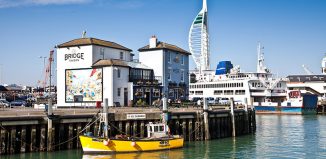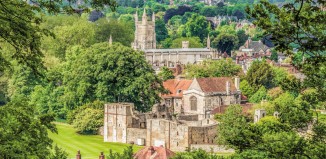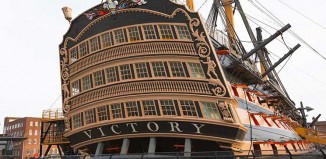Portsmouth city walk
This trail takes you through parts of the old town of Portsmouth, highlighting places and buildings of interest relating to Vice Admiral Lord Nelson and the city around the time of the Battle of Trafalgar. Look out for the four interpretation panels along the way that provide more detailed information
1. Start
Nelson would have entered Portsmouth through Landport Gate which was the main gateway to the town until 1875. On the morning of 14 September 1805 the admiral passed through this gate for the last time, on his way to join HMS Victory. It
is the only town gate still in its original position. Cross St George’s Road at the zebra crossing and turn right into High Street.
2. The Portsmouth Grammar School
Founded in 1732, by 1805 the school was at what is now 30 Penny Street. It has occupied this site since 1926. Prior to that date, the buildings formed part of the
Army’s Cambridge Barracks, built in 1856. As with most schools of the period, the pupils would have been the sons of more prosperous families. In 1805, the original Theatre Royal stood just to the right hand side of the school archway.
Continue on this side of High Street to view the Tudor Buckingham House where George Villiers, Duke of Buckingham, was assassinated on 23 August 1628. Enter the garden to John Pounds Memorial Church.
3. 12-16 High Street
This is a collection of typical Georgian houses, reminding one of how High Street would have looked in 1805 when Nelson passed by on his final journey to the George Inn. Although some of the windows have been altered, the houses give an idea of the general appearance of High Street as Nelson would have seen it. Sadly many of the other fine Georgian buildings were destroyed during the Second World War.
As you walk further down High Street, on your right is Highbury Street.
4. The George Inn
On 14 September 1805, Nelson ate his last breakfast on English soil at The George. Crowds had gathered outside the inn on the morning of his departure to join
HMS Victory. To avoid them, Nelson chose to go out through the back door into Penny Street. From here he began his final walk to the beach to be rowed out to the ship. The room Nelson stayed in was preserved as a tribute to him until the building, known at that time as the George Hotel, was destroyed on 10 January 1941, during the worst air raids to hit the city. Continue on until you reach the cathedral on your right.
5. Portsmouth Cathedral
The cathedral would have been familiar to Nelson and the other naval officers who frequented the town. In 1805, it was the parish church of St Thomas and only
about half the size of the present building, completed in the early 1990s. It would have been entirely screened from High Street by buildings, long since demolished. The cathedral houses many treasures, including a cross made of timber from HMS Victory
and a piece of the flag that was laid on Nelson’s coffin at his funeral on 9 January 1806. You are now approaching the Square Tower.
6. Square Tower
Constructed in 1494 as a residence for the governor of Portsmouth, the Square Tower has had many uses. In Nelson’s day, the building was used by the Admiralty as a meat store; beef could be conveniently shipped out to the fleet moored at Spithead from the pier on the seaward side, known as the Beef Stage. Walk past the houses in Battery Row and you will see the statue of Nelson. From there take the footpath from the Royal Garrrison Church to the site of Trafalgar House at 29-31 Pembroke Road.
7. Trafalgar House
It is claimed that Nelson’s favourite sister, Mrs Matcham, bade her brother goodbye in a house in Pembroke Road. It was named Trafalgar House in his honour. The front doorstep survives in the City Museum’s collection and is inscribed ‘It was here Lord Nelson spent his last hours in England’. The house was destroyed during the Second World War. Continue along the path and turn right into the tunnel.
8. Nelson’s Bridge
It is thought that, on 14 September 1805, Nelson walked over a wooden drawbridge in this very location as part of his last walk on dry land. The new bridge was constructed in 2005 to commemorate the bicentenary of the Battle of Trafalgar. Continue along the promenade through the fun fair to the Victory anchor.
9. The Victory Anchor
The anchor from Nelson’s flagship at the Battle of Trafalgar, HMS Victory, was preserved as a monument to the fallen hero and all those that perished in the battle. Its location has changed several times since it was first positioned in 1852, and finally moved to its current position in the late 1880s.
Information
The walk: A straight-forward tour with sites within close range of one another. Flat going.
Parking: There are several city centre car parks. Try the multi storey on Admiralty Road off Queen Street, which is a short walk to the entrance to the Historic Dockyard. Alternatively try Broad Street, Old Portsmouth situated on the right as you travel along Broad Street towards the Point.
Distance: About a mile. Allow an hour and a half to view all the sites en route.







